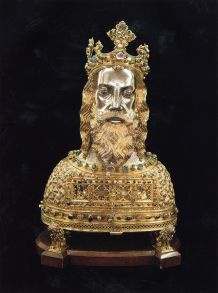Period Band A
Royal Spaces in Medieval Europe: Church, City & Realm
Tutor: Michele Vescovi
Description
This module examines the cult of kingship in medieval Europe and the creation of different kinds of ‘royal spaces’. It offers an introduction to medieval art and architecture from a variety of methodological perspectives, following and yet interrogating an integrated approach to art across a broad variety of media. Through three detailed case studies of key monuments and sites, the module considers how the royal image could be negotiated and mapped onto the church, city and realm.
Having considered Antique and early medieval models of royal artistic patronage, we turn to our first case study, the Sainte-Chapelle in Paris. Examining in particular its architecture and stained glass, we consider its decoration in relation to Capetian royal ideology, the rhetoric of Crusade, devotion to Passion relics, and contemporary illuminated manuscripts. In many respects the Sainte-Chapelle set the pattern for royal artistic patronage and devotion throughout medieval Europe. We then widen our focus and analyse the patronage of Charles IV of Bohemia and his creation of an urbs regia in his capital, Prague. Here we are concerned not only with the cathedral and adjacent royal castle, but with the creation of ceremonial routes and spaces through the city, where royalist imagery could be ‘activated’ on special occasions.
Our final case study is a whole kingdom, Castile. With no dedicated administrative or ceremonial capital, Castile’s most ambitious cities continually vied for royal preferment throughout the thirteenth and fourteenth century, while its southern borders expanded ever further at the cost of the peninsula’s Islamic polities. We examine the particular and unsacral nature of the Iberian monarchies, their imitation of French commemorative strategies, the role of the Cantigas de Santa Maria in fostering a sense of national identity, and shared presentational strategies with the Islamic (Nasrid) rulers of Granada.
Objectives
By the end of the course students should have acquired:
- detailed knowledge of key sites and objects from across medieval Europe, including an introduction to non-Christian traditions
- familiarity with a wide range of methodological approaches to medieval material culture
- an ability to critically evaluate sources and historiography
- the theoretical tools for considering relationships between art and power
- an ability use a wide range of sources in research
Preliminary Reading
Essential reading
Camille, M., Gothic art, London (various editions). The best general introduction to the art of our period (cheap on Amazon)
Crossley, P., 'Medieval architecture and meaning: the limits of iconography', Burlington Magazine, vol. 130, 1988, pp.116-122. An introduction and warning about the interpretation of architecture (available on JSTOR)
Wilson, C., ‘Calling the Tune? The Involvement of King Henry III in the Design of the Abbey Church at Westminster’, Journal of the British Archaeological Association, vol. 161, 2008, pp.59-93 (available on SFX-University of York)
If you want to get ahead for this term then you could read these (especially the first). Each introduces our three major case studies.
# * Jordan, A. A., 'Stained Glass and the Liturgy: Performing Sacral Kingship in Capetian France', in C. Hourihane (ed.) Objects, Images, and the Word: Art in the Service of the Liturgy, Princeton,N.J., 2003, pp.274-297. An introduction to the Sainte-Chapelle, or Jordan, A. A., 'Material girls: Judith, Esther, narrative modes and models of queenship in the windows of the Sainte-Chapelle in Paris', Word & Image, vol. 15, 1999, pp.337-350 (available on
SFX-University of York)
Crossley, P., 'The Politics of Presentation: the Architecture of Charles IV of Bohemia', in S. Rees Jones, R. Marks and A. J. Minnis (eds.), Courts and Regions in Medieval Europe, York, 2000, pp.90-172. For Prague.
Crites, D. 'Churches Made Fit for a King: Alfonso X and Meaning in the Religious Architecture of Post-Conquest Seville ', Medieval Encounters, 15, 2009, pp. 391-413 (available on SFX-University of York)

